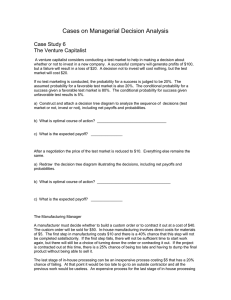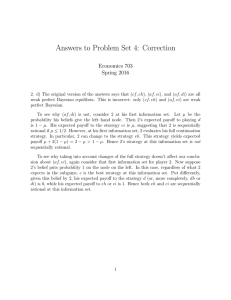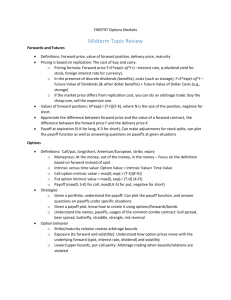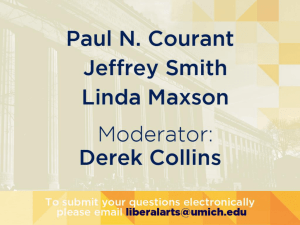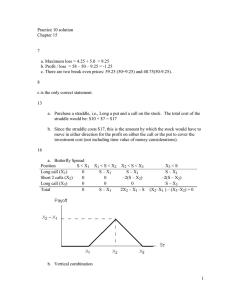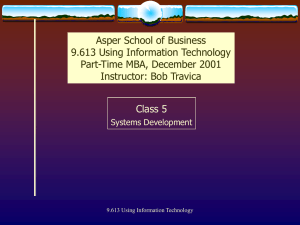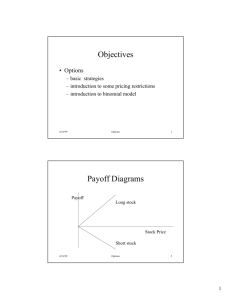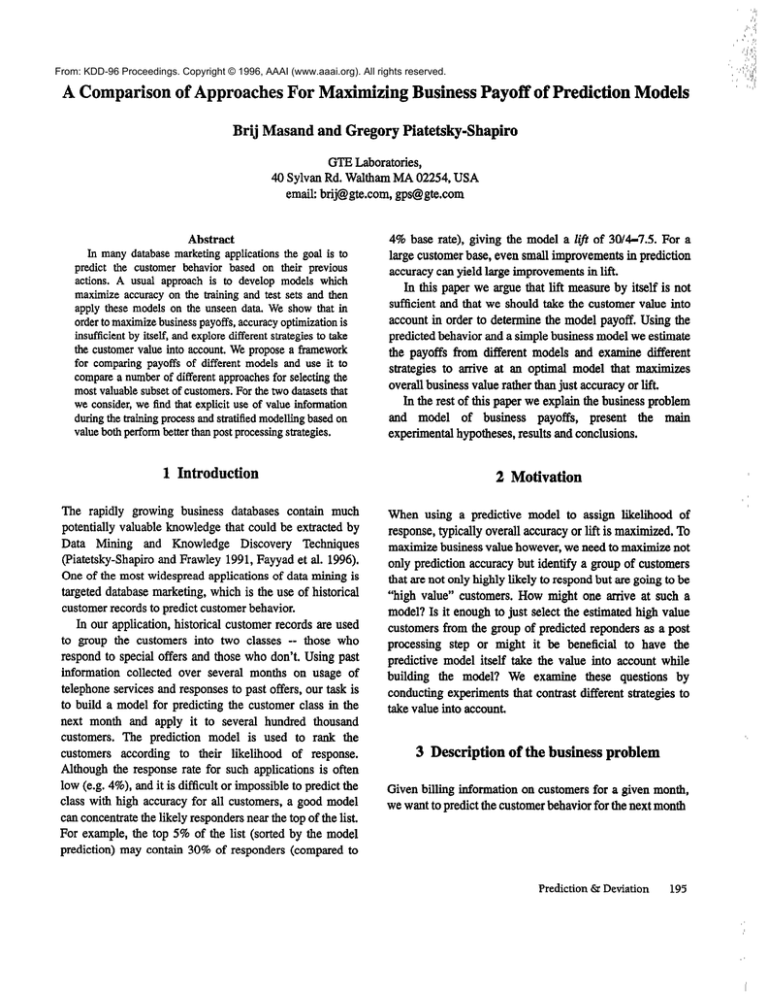
From: KDD-96 Proceedings. Copyright © 1996, AAAI (www.aaai.org). All rights reserved.
A Comparison of ApproachesFor Maximizing BusinessPayoff of Prediction Models
Brij Masand and Gregory Piatetsky-Shapiro
GTE Laboratories,
40 Sylvan Rd. WalthamMA 02254,USA
email: brij@gte.com, gps@gte.com
Abstract
In many databasemarketing applications the goal is to
predict the customer behavior based on their previous
actions. A usual approach is to develop models which
maximize accuracy on the training and test sets and then
apply these models on the unseen data. We show that in
order to maximize businesspayoffs, accuracyoptimization is
insufficient by itself, and explore different strategies
to take
the customer value into account. We propose a framework
for comparing payoffs of different models and use it to
compare a number of different approachesfor selecting the
most valuable subsetof customers.For the two datasetsthat
we consider, we find that explicit use of value information
during the training processand stratified modelling basedon
value both perform better than post processingstrategies.
1 Introduction
The rapidly growing business databasescontain much
potentially valuable knowledge that could be extractedby
Data Mining and Knowledge Discovery Techniques
(Piatetsky-Shapiroand Frawley 1991, Fayyad et al. 1996).
One of the most widespreadapplicationsof data mining is
targeteddatabasemarketing, which is the use of historical
customerrecordsto predict customerbehavior.
In our application, historical customer records are used
to group the customers into two classes -- those who
respondto special offers and those who don’t. Using past
information collected over several months on usage of
telephoneservicesand responsesto past offers, our task is
to build a model for predicting the customer class in the
next month and apply it to several hundred thousand
customers. The prediction model is used to rank the
customers according to their likelihood of response.
Although the responserate for such applications is often
low {e.g. 4%), and it is difficult or impossible to predict the
class with high accuracyfor all customers,a good model
can concentratethe likely respondersnear the top of the list.
For example, the top 5% of the list (sorted by the model
prediction) may contain 30% of responders(comparedto
4% base rate), giving the model a Zifcof 30/4-7.5. For a
large customerbase,even small improvementsin prediction
accuracycan yield large improvementsin lift.
In this paper we argue that lift measureby itself is not
sufficient and that we should take the customer value into
account in order to determinethe model payoff. Using the
predictedbehavior and a simple businessmodel we estimate
the payoffs from different models and examine different
strategies to arrive at an optimal model that maximizes
overall businessvalue rather than just accuracyor lift.
In the rest of this paper we explain the businessproblem
and model of business payoffs, present the main
experimentalhypotheses,results and conclusions.
2 Motivation
When using a predictive model to assign likelihood of
response,typically overall accuracyor lift is maximized. To
maximize businessvalue however,we needto maximize not
only prediction accuracybut identify a group of customers
that are not only highly likely to respondbut are going to be
“high value” customers.How might one arrive at such a
model? Is it enough to just select the estimatedhigh value
customersfrom the group of predicted repondersas a post
processing step or might it be beneficial to have the
predictive model itself take the value into account while
building the model? We examine these questions by
conducting experimentsthat contrast different strategiesto
take value into account.
3 Description of the business problem
Given billing information on customersfor a given month,
we want to predict the customerbehaviorfor the next month
Prediction &I Deviation
195
Table 1:
Example data fields from Customer Billing Record (Aug 95)
customer
optional
response
service
Feature 1dCarrier service to offers
length
calls
Charge
and arrive at a ranking of all subscribersfor the purposeof
extendingoffers to the top few percentfrom such a ranked
list, The billing data (see Table 1) includes such
information as total amountbilled, unpaid balances,use of
specific (telephone)services, customer service calls plus
information on length of service and past marketing
behavior e.g. whether they acceptedcertain offers or not.
The sample databasewe use includes information for
100,000 customers with about two hundred fields per
rmntrrmnr
LlI,tUC”.ll”I
nor
yu mnmth
AA.“IIU.*
etmvlcerl
nnnrrmr;h
rlA ULullUuAU
uyya”u”AA
+n
nrnhlem
L” thic
U..” p”“lrrxl
ic
S”
to regard it as a classification problem and use one of the
machine learning methods such as neural networks
(Rumelhart 1986), decision tree induction (Quinlan 1993)
or nearestneighborclassifiers(Dasarathy1991)and build a
predictive model that maximizes some criteria such as
overall accuracy,lift in the top 5%.
For the experimentsdescribedin this paper, we use a
commercial neural network software package from
Neuralware.The following stepsdescribehow we prepare
the datafor modelling.
3.1 Pre-processing and sampling data for analysis
Our first sample databasecomprisesof 25,000 records
from a particular market. Based on historical data, typical
responserate for this application(respondingto offers) are
in the vicinity of 7%. For the purposeof building a model
we needa more concentratedrepresentationof responders.
This is becausewith a sparse responserate, a learning
method can achieve high accuracy by always predicting
everyoneto be a non-responder.
We create a random sample where we include about
2000 respondersand then add enough non-respondersto
make a datasetof 50-50 concentrationof responders.For
each one of theseindividuals we include information from
one previousmonth.
We divide this dataset (about 4000 records) into
approximately2/3 and l/3 size training and test setswith a
50-50 concentration of responders.A separaterandom
196
KDD-96
25.0
4.0
280
2
0
12.0
6.0
280
0
1
30.0
2.0
280
0
0
sampleof 6000 records(with no overlap with the train, test
sets)is held asidefor evaluationpurposes.
A second,larger sampleis drawn from a different market
with 100,000records and a much lower responserate of
about 2%. Following similar stepstraining and test sets of
size about 4000 each are created and a non-overlapping
heldaside set of 24,000 records is kept separately for
evaluation.
3.2 Reducing the number of data fields for model
development
As reported in (Kohavi & Sommerfield 1995) and
(Almuallim & Dietterich 1991), reducing or eliminating
irrelevant data fields can result in improved classification
accuracy.We first excludedfields that have constantvalues
as well 1 as dependentfields such as tax charges.In orderto
prune the data fields further, we correlatedeach field with
the target field and arrived at a smaller list of fields per
month (about40). While in generalit may not be desirable
to exclude fields before the application of a learning
procedure,in this case our goal is to compare different
learning strategiesto maximize businesspayoff from the
models, therefore just including the “best n” fields still
serves the purpose of contrasting different modelling
strategies.
3.3 Methodology of testing
In order to estimate the accuracy and payoff of different
models their ability to predict needs to be tested on a
representationof “unseen”data. For our experimentsthe
neuralnetwork training was doneusing the 50-50 train and
the test sets,using the test set to prevent overtraining.Once
the models were developed, they were applied to the
heldasideset to computethe ranked list of subscribersand
to estimatemodel payoffs on unseendata.
na&:hifivcI non-resnnnflern
---_- ---=--- --_- ~yeri&s
the benefit of c------nntential
response.Thereis an estimated“optimal” numberof people
to call, in this caseabout 15% giving an estimatedoptimal
payoff of about $72 k for this group. If this was linearly
scaled to 100,000customersthis payoff would represent
about $1.l million. (In practice we have observeda nonlinear scaling, giving a higher lift and payoff for larger
samples).
4_ Main
-.--I
exnerimental
-‘-=-----I-
hvnnthecew
-J =---- L-Li v&e
hmed
training vs. post processing
I 20%
1 7.30
30%
6.35
322
67.08
2.24
-0.15
71.40
t 50%
5.71
392
81.67
1.63
-2.08
67.97
Given the above definition of business payoff in this
domain,we now examinedifferent strategiesfor the task of
optimizing the payoff. Essentiallywe would like to rank the
subscriberbasein such a way that the peoplewho are most
likely to respond are at the top of the ranked list. In
addition, we would like to identify a group of customers
that are likely to respondto high value offers. For example,
it might be better to extend offers to a smaller group of
peoplewith a moderatelikelihood of responsebut with the
high expectedrevenue,rather than a group of customers
that with a higher likelihood of response but a lower
expectedrevenue.
We ask the question: Is it enough to use a predictive
model to arrive at rankedlist of subscribers,and then, as a
post processingstep select the “high value” customers(as
estimated from their past behavior) or is it necessaryto
somehowinclude the notion of value in the training process
itself7 Should we stratify customers into high value
customers and low value customers and build different
models for them? We examine and contrast the following
four approaches:
1 70%
3.02
431
89.79
1.28
-4.54
58.99
4.1 Baseline payoff calculation
80%
2.54
447
93.12
1.16
-4.63
54.36
90%
1.75
458
95.42
1.06
-5.05
Using a basic predictive model we establisha baseline
payoff against which all improvementscan be measured.
The payoff calculations are done as explainedin sections
3.4 and 3.5. It is important to note that what we call “value”
(various sources of revenue) are present as some of the
inputs, although their use is to predict a likelihood of any
responseat all (a classification problem) rather than an
absolutemagnitudeof the response(a regressionproblem).
‘lhble 3: Example lift table for ranked output log for 6,300
customers
I
segment
hit
rate
per
segment
1 15% 1 15.24
/ioo+4g
I
I
CUIll%
I
payoff
cum
payoff
(x
low
abs
hits
of
all hits
caphued
144
30.00
6.00
61.13
61.13
206
42.92
4.29
8.02
69.15
1 3.53 1 3.14
1 72.29
1 2.89 1 -0.48
1 71.81
CUlll
254 1 52.92
1 277 1 57.71
1 ,^^
480
I _^^^
1 1uu.o
lift
I _^
1 1.0
per
seg
(x
loW
I --1 -3.37
49.31
I .--.
1 45.Y4
The figure below (basedon slightly different data from
the above table) shows an optimal cutoff point from the
ranked prediction log for an optimal payoff. Here the
optimal point is about 11%for a payoff of $82k.
. .. .,..,...
. . ...~C.---.-e-.-L...
........I
. . . . . ... .
--A.
/
-1
;
‘----i...~ 4
7coca
‘““\._ 5.1
I
I
f
198
KDD-96
4.2 Post Processing
We examine a simple strategy to re-rank the basic
ranked list using a criteria that takes both likelihood of
~oaw.n,,~~
‘“VyvAAuv
nnA thn
sr\t,,nl
UAAU
UI” -cuw
a&mot,.4
““LILueuu
.r.,l,.~
Ia”*
fwh:A.
\nuru
;n ruuAuaI*u
n&;mnt.4
10
from the input revenuevariables).We use a product of the
two factors as a composite rank factor. This simulates
“expected value” even though the likelihood as estimated
from the neural net prediction is not a strict probability.
Thus subscriberswith a high likelihood but low estimated
value may not be near the top of the list becauseanother
subscriberwith a moderatelikelihood but high value might
have a higher compositescore.
merging the entire output logs from the two stratified
models while the last row describesthe results obtained by
merging only optimum subsetsfrom the output of the two
stratified models.
.Tabie6: Dataset2, Comparisonof Optfmumpay&& (x %lOOO)
experi-
input input I y;;
25
35 1
: dev)
ment
5.4 Comparison of optimal payoffs with best
accuracy and lift
More details related to the experiments for Dataset 1 in
Table 5 can be found in Table 7 where the first column
:,A ^__^_AL-__I-A---L- IL----a me
r*.. remammg
~--~---+*
uiwm~
uw ~qmrrnc;nw
mm m,ctmule 3z ana
lltble 7: Comparkm of OptSmumpayoffsvs. accuracyand lift
1 basicopt
Payoff
2 basic
resorted
opt payoff
t
3 value
58*6
mining
opt payoff
59.3
5%3
stratl
54.7
merge
opt payoff
53.3
54.0
58.1
55.6
f
5 atrat2opt 58.3
merge
opt payoff
5.1 Improvements using post processing
We found that re-ranking based on the product of the
likelihood of response and estimated revenue does not
results in a significant change for Dataset 1 while for
Dataset 2 there is an improvement (95% confidence level
for a test comparing the difference between means of two
populations)
5.2 Improvements using vaiue based training
As can be seenby comparing the third and the first row of
Tables5 and 6, the results from the value basedtraining are
significantly better than the payoffs from the basic model
and also consistently better than the post processing
strategy
5.3 Improvements using training based on
stratified models
we expected the resuits to improve significantly using the
straight merge from the stratified models but the best
comparableresults to value basedtraining were obtainedby
merging the optimum subsets from the stratified model
outputs.
200
KDD-96
.
‘WW
JO.,&
5 basic opbnergestrat235
77.22
36.12
34.02
2.33
columns describeparameterssuch as accuracyand lift. It is
generally expectedthat high accuracy and high lift will be
correlated with a high payoff model, however as cau be
seenfrom Table 7, the best payoffs are not correlatedwith
th.e best a_r.r.ugq or -hiphenf
---- lift.
---. This
-_-_Iin
-- snnnisferrf.
--------- -- with
..-- the
explmation that when we rank subscribers with just the
fikelihaod of response9there is no necessarycorrelation
between high likelihood of responseand high magnitude
(high value) of response,Thus the strategy which achieves
high lift in predicting subscribersmay not have tht?highest
payoff value.
Another dimension of comparison can be the optimal
percentof subscribersselectedfur the optimal payoff<For a
comparable payoff, a smaller set of selected subscribers
a,*
*.. .*
woura ue prereraote.
We addressthe problem of identifying an optimal subset
of customers with highest estimated payoff for extending
offers to them, We find that for our domain, using neural
network models on two datasets, different ln size and
responserates, the value based training strategiesand the
stratified optimal merge approach outperform the simple
post processingstrategybasedon re-ranking using expected
value estimates.
6,I. Discussion and AnaIysis
One might ask whether the high valne stratified group (top
25%) is not sufficient by itself to produce the highest
payoffs. We found that there are enough moderate value
*‘
L+...-a*.., 11,
:, AL..
..,-,:.I.:,, J7ct-K
,.._^I. A...‘
d.^
..-.43?&.,&
lGbp”IkuP18
“lci IGllMlI1111~
13-m~“c;lI
LIISLL
“IF yayuu
lt”tll
the top 25% alone cannot match the highest payoffs from
the value basedtraining.
While new m-ranking factors for post processing can
perhaps be discovered by methods such as Genetic
Programming or manual heuristics, we show 8 definite
improvement using a value based response variable for
training acrossa rangeof model complexity as measuredby
different number of inputs. It’s not clear yet if this approach
would apply to different domains with a similar sparse
response rate and value criteria (e,g, a domain such as
credit card attrition).
error estimatesfor the optimum payoffs to better assessthe
statistical significanoe of the relative ranking of different
strategies. We are also experimenting With variations of
value based training such as re-ranking the output logs of
the value basedmodel and also doing value basedtraining
on stratified sets,
7
AchnowIs?dgmeats
We would like to thank John Vittal for his supportof this
pfoject,
8 References
ArimuailimW.andDietterichT. 1991,Learningwith Many hrelevant Features.In Proceedin;gs
of AAAI-9f,547-552. MenloPark,
cpr: AAL4.lPress.
I)astitfkyf 3.Y 1991.iVeare#tNeighbor Norms: NN Pattern Clarsifiatioti techtziques,LOSAlamkx, CA: IEEE Press.
Fayyad,I& Piatetsky&hapiraIG., P. Smyth,andUthurusamy,
R.
1996. Advarices irr KY&~&
bridge, Iv& AAMMIT
Discovery and Data Mining, Cam.
Kohavi,R. and Sommerfleld,D. 1995.FeatureSubsetSelection
Using the WrapperM&ho& Gvt?rtlttingand Dynamic Search
SpaceTepology.In Proceedingsof KDD-95: First International
Conference
on KnowledgeDiscoveryandDataMining, 192--197.
MenloPark,CA N
Press.
Plaf.et&y-Shapiro,
G. and Frawley,W. 1991.Knowledge Discovery in Databases, Cambtidgt?,MA: AAAIIMIT Press.
Rumelhart,D. E., Hinton,G, E. & Williams,R. J. 1986.Leaming
internalrepresentations
by errorpropagation,In Parallel Distributed Processi@: Explorations in the microstructure of cognition.
Volume I: Fotou&ations. Cambridge,MA: MIT Press/Bradford
Books, pp 328 - 362.
QtWti, j, R. 1993.C4.4: Prograitu for Machine Learning. Los
Qatos, CA: Morgan Kmffman~
6.2 Extensions
Methods such C4.5 aud KNN classification can also be
modified for value basedtraining. We are adding bootstrap
Prediction Es Deviation
201

